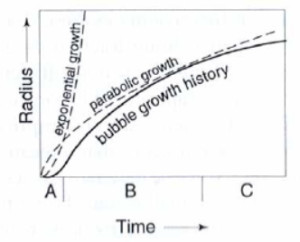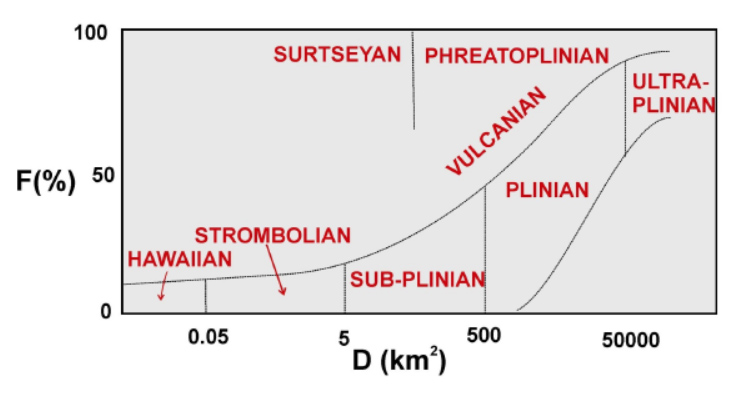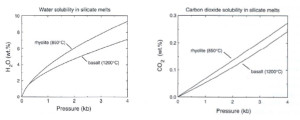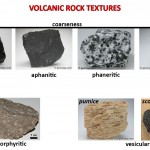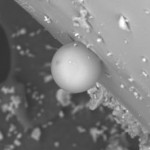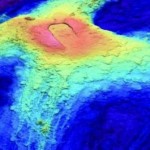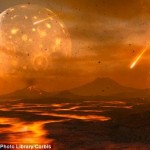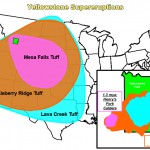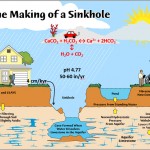This post will focus on the processes driving volcanic eruptions (for more details on all things volcano, visit this awesome site by SDSU). The most important factor controlling eruption type is the composition of the lava, which controls how much gas the lava contains. The more viscous the lava, the more gas it traps—and the more gas, the more explosive the eruption.
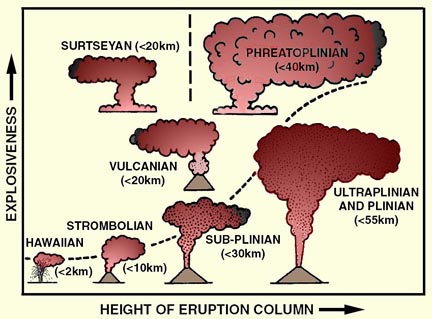 How does lava composition affect explosiveness?
How does lava composition affect explosiveness?
Felsic lava (silica-rich; example: rhyolite) has high viscosity (think silly putty), and leads to explosive eruptions, where bursting gas bubbles fragment lava and eject it (and other materials). Since felsic lava does not flow easily, it tends to form steep sides.
Mafic lava (silica-poor; example: basalt) has low viscosity (think ketchup), which allows gas bubbles to easily escape and results in effusive eruptions, where lava pours out of the ground. Since mafic lava flows easily, it can cover very long distances.
Why is felsic lava more viscous?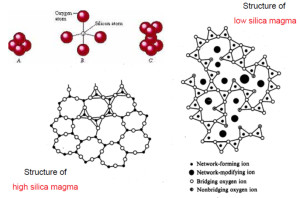
- Silica bonds to itself, creating chains that link together and resist movement; this is called polymerization.
- Silica-rich lava has a lower temperature than silica-poor lava. Think of warm honey versus cold honey (or warm butter versus cold butter); the warmer substance flows more easily.
Why does felsic lava trap more gas?
The answer lies in felsic lava's high viscosity. Imagine gas bubbles trapped inside honey and bubbles trapped inside soda. The bubbles in the soda can easily escape, because soda has low viscosity. Honey, however, has high viscosity, which prevents the bubbles from easily moving.
Why does magma rise?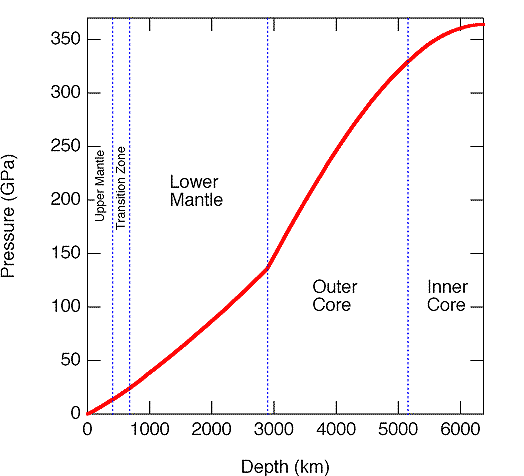
The deeper you travel down into the earth, the greater the pressure (due to the weight of the overlying material). Magma is buoyant, and rises from areas of higher pressure (deep in the earth) to areas of lower pressure (the surface of the earth). Pressure can be easily calculated by multiplying gravity, the height of the overlying material, the density of the overlying material (P = ghρ). The deeper the magma, the more pressure exerted on it, and ultimately, the higher it can travel. However, you've probably noticed that lava isn't constantly bursting out of the earth. Usually, something special needs to happen for magma to rise—for example, when tectonic motion creates a crack in the lithosphere.
How do bubbles grow?
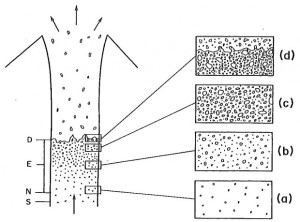 The most common gases released by volcanoes are (in descending order): water vapor (H2O), carbon dioxide (CO2), sulfur dioxide (SO2), and hydrogen sulfide (H2S). At higher pressures, these volatiles are kept in solution, but when the pressure comes off, they exsolve and form gas bubbles. As pressure decreases further, the bubbles expand—until they pop.
The most common gases released by volcanoes are (in descending order): water vapor (H2O), carbon dioxide (CO2), sulfur dioxide (SO2), and hydrogen sulfide (H2S). At higher pressures, these volatiles are kept in solution, but when the pressure comes off, they exsolve and form gas bubbles. As pressure decreases further, the bubbles expand—until they pop.
You see this in action when you shake then open a soda can. When the can is closed, the contents are under pressure and the gases stay dissolved; when the can is opened, the pressure goes down, and bubbles spill out.
- Exponential: bubbles grow rapidly as volatiles diffuse in; growth is limited by viscosity (higher viscosity makes growth difficult) [A]
- Parabolic: now that the bubble is large, diffusion can not keep pace with its growth (growth is now diffusion-limited) [B]
- Due to their increased size and number, bubbles must compete with other bubbles for space and gas, which slows their rate of growth [C]
- Decompression: the pressure acting on the bubbles decreases as magma rises, allowing bubbles to expand; this may lead to fragmentation (bubbles bursting)
- Fragmentation: when bubbles burst, the magma mixture changes from one of bubbles in melt to one of melt droplets in a stream of gas
After fragmentation, the magma density is much lower than before, which causes the magma to accelerate upwards. The gas-melt mixture that rushes out of the volcano is called the eruption column, and the more gas, the more explosive the eruption. Two-phase system refers to the relative motion between lava and gas.
Felsic magma can hold more water and carbon dioxide in solution than can mafic magma. However, because the low diffusion and high viscosity in felsic magma limits bubble growth, felsic magma supports smaller bubbles (0.001-0.1 cm) than mafic magma (0.1 - 5 cm).
The Eruption Column
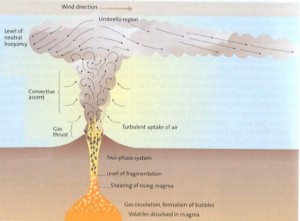 Gas Thrust / Jet Region: gas and pyroclasts are hurled upwards at great speed: 100 m/s in Hawaiian eruptions, compared to >600 m/s (that's supersonic!) in Plinian eruptions
Gas Thrust / Jet Region: gas and pyroclasts are hurled upwards at great speed: 100 m/s in Hawaiian eruptions, compared to >600 m/s (that's supersonic!) in Plinian eruptions- Convective Ascent Region: rising heat captures air and heats it; heated air and ash rises at 10-100 m/s; the width of the column increases with height
- Umbrella Region: when density of plume matches the density of the atmosphere, the plume stops rising and begins spreading laterally
Volcanic Materials
More powerful (explosive) eruptions can eject larger materials. Ejecta can be described by size: ash (<2 mm), lapilli (2-64 mm), and bombs/blocks (>64 mm). Read my post about volcanic rocks and deposits for more information, including a more details on characteristics of rhyolite, andesite, and basalt.
Types of Volcanoes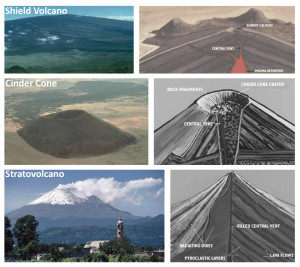
- Shield volcano: broad, gently sloping volcano built from fluid basaltic flows, named because it resembles a viking shield laying face-up
- Cinder cone: steep piles of volcanic debris and some lava flows; can form as parasitic cones on larger volcanoes
- Stratovolcano (composite volcano): typically formed from andesitic eruptions, relatively steep-sided volcano named for its alternating layers of pyroclastic material and viscous lava flows; the unconsolidated pyroclastic layers tend to cause landslides
Volcano Terminology
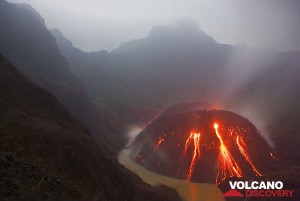
Lava dome forming over a vent inside a crater. Image: Volcano Discovery
- Magma: molten material below the surface of the earth
- Lava: molten material above the surface of the earth
- Vent: opening through while magma comes
- Fissure vent: long, linear vent
- Fumarole: vents that mainly release gas
- Crater: constructional feature formed as volcanic material builds up around a vent
- Caldera: destruction feature formed when a volcano collapses, leaving behind a hole
- Dome: very viscous lava can't flow easily, so it tends to form a dome over the vent
Types of Volcanic Eruptions
Hawaiian Eruptions
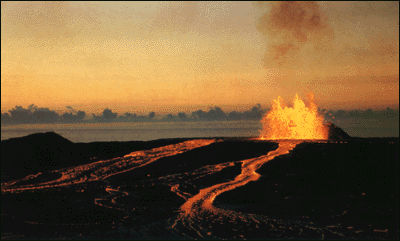 Hawaiian eruptions are effusive. Their fluid basaltic flows cover large areas; repeated flows can build on top of each other to form broad, gently sloping shield volcanoes. This type of eruption typically forms over hot spots (areas where magma from the mantle rises to the surface).
Hawaiian eruptions are effusive. Their fluid basaltic flows cover large areas; repeated flows can build on top of each other to form broad, gently sloping shield volcanoes. This type of eruption typically forms over hot spots (areas where magma from the mantle rises to the surface).
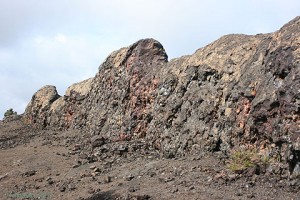 Beautiful fire fountains can occur as lava sprays out of the vent; if lava pieces agglutinate, lava blebs can collect into spatter domes or ramparts. Spatter can help reveal the direction the lava flowed: since moving lava would carry the blebs away—preventing the formation of the spatter dome—lava must have been flowing in the opposite direction of the spatter feature.
Beautiful fire fountains can occur as lava sprays out of the vent; if lava pieces agglutinate, lava blebs can collect into spatter domes or ramparts. Spatter can help reveal the direction the lava flowed: since moving lava would carry the blebs away—preventing the formation of the spatter dome—lava must have been flowing in the opposite direction of the spatter feature.
- Explosiveness: Low
- Lava: Basalt
- Viscosity: Low
- Volatile Content: Low
- Eruption Column Height: 0.1 - 1 km
- Recurrence Interval: Hours-Days
Strombolian Eruptions
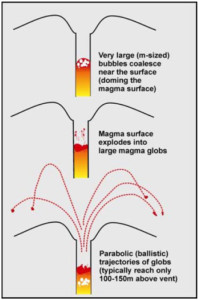 Strombolian eruptions, which are not very viscous, build steep-sided composite volcanoes. The so-called Strombolian burp occurs when gas builds just below the surface and then explodes, flinging material (mostly coarse, like lapilli and bombs) in parabolic trajectories that do not reach far from the vent.
Strombolian eruptions, which are not very viscous, build steep-sided composite volcanoes. The so-called Strombolian burp occurs when gas builds just below the surface and then explodes, flinging material (mostly coarse, like lapilli and bombs) in parabolic trajectories that do not reach far from the vent.
- Explosiveness: Low-Moderate
- Lava: Basalt-Andesite
- Viscosity: Low-Moderate
- Volatile Content: Low-Moderate
- Eruption Column Height: 0.1 - 5 km
- Recurrence Interval: Days-Months
Vulcanian Eruptions
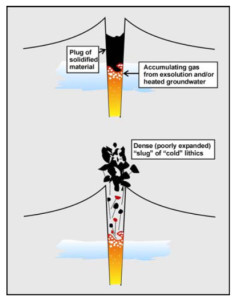 Vulcanian eruptions have moderately viscous lava, and so have thick, stubby flows (if any) with some ash. Compared to Strombolian eruptions, the gas is deeper and more constrained; during Vulcanian throat-clearing, this gas escapes and expels overlying solid material. They often produce paninos (bread-crust bombs).
Vulcanian eruptions have moderately viscous lava, and so have thick, stubby flows (if any) with some ash. Compared to Strombolian eruptions, the gas is deeper and more constrained; during Vulcanian throat-clearing, this gas escapes and expels overlying solid material. They often produce paninos (bread-crust bombs).
- Explosiveness: Moderate
- Lava: Andesite-Dacite
- Viscosity: Moderate
- Volatile Content: Moderate
- Eruption Column Height: 3 km - 15 km
- Recurrence Interval: Months-Years
Pelean Eruptions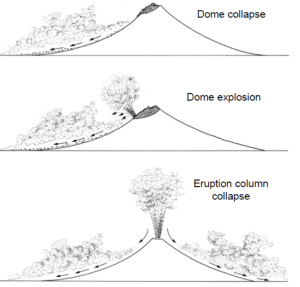
Pelean eruptions are similar to Vulcanian eruptions, but have more viscous lava. Any flows will be very thick, and domes are typical. Due to dome collapse, pyroclastic flows are common, often as nuee ardentes (glowing avalanches). Pyroclastic flows can occur when the dome capping the volcano collapses or explodes, or when the eruption column collapses.
- Explosiveness: Moderate-High
- Lava: Andesite-Dacite-Rhyolite
- Viscosity: Moderate-High
- Volatile Content: Moderate-High
- Eruption Column Height: 10 km - 25 km
- Recurrence Interval: Years
Plinian & Ultra-Plinian Eruptions
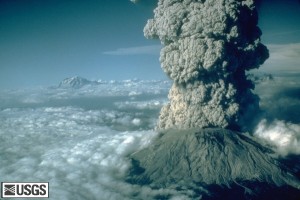 The most violent and dangerous eruptions by far, Plinian eruptions are associated with volcano collapse, can last hours, and have eruption columns that reach up to 40 km into the sky. They occur from the rapid decompression of large volumes of gas‐rich magma. They release tons of ash, producing extensive ash flow sheets (ignimbrites). The 1980 Mt. St. Helens eruption was an example of a relatively small Plinian eruption.
The most violent and dangerous eruptions by far, Plinian eruptions are associated with volcano collapse, can last hours, and have eruption columns that reach up to 40 km into the sky. They occur from the rapid decompression of large volumes of gas‐rich magma. They release tons of ash, producing extensive ash flow sheets (ignimbrites). The 1980 Mt. St. Helens eruption was an example of a relatively small Plinian eruption.
- Explosiveness: High-Very High
- Lava: Rhyolite
- Viscosity: High
- Volatile Content: High-Very High
- Eruption Column Height: > 25 km
- Recurrence Interval: 5-1,000 years (Plinian); 1,000-100,000 years (Ultra-Plinian)
Phreatic Eruptions
Phreatic eruptions occur when groundwater finds its way close to magma source and gets super-heated; steam instantly forms, bursting out of the volcano in an explosion of ash, and rock. Phreatic eruptions are much harder to predict than other styles, because they don't necessarily involve the magma injections that provide tell-tale ground deformation and long period earthquakes days or weeks ahead of time.
Phreatomagmatic Eruptions
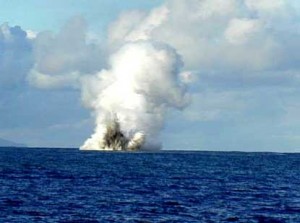 Phreatomagmatic eruptions result due to interactions between water and magma. Surtseyan eruptions are eruptions that occur underwater. Due to the intense heat, the water rapidly expands, so usually, water takes an eruption and makes it more explosive. However, sometimes, film boiling occurs when a film of water instantly vaporizes around the lava. The vapor layer insulating the lava from the water and prevents an explosive eruption—but if the films collapse, the eruption can turn explosive.
Phreatomagmatic eruptions result due to interactions between water and magma. Surtseyan eruptions are eruptions that occur underwater. Due to the intense heat, the water rapidly expands, so usually, water takes an eruption and makes it more explosive. However, sometimes, film boiling occurs when a film of water instantly vaporizes around the lava. The vapor layer insulating the lava from the water and prevents an explosive eruption—but if the films collapse, the eruption can turn explosive.

